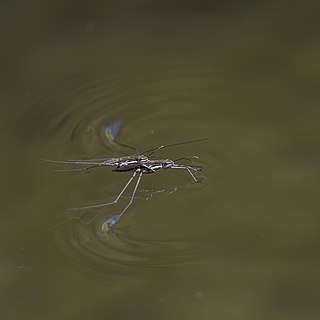
The Gerridae are a family of insects in the order Hemiptera, commonly known as water striders, water skeeters, water scooters, water bugs, pond skaters, water skippers, water gliders, water skimmers or puddle flies. Consistent with the classification of the Gerridae as true bugs, gerrids have mouthparts evolved for piercing and sucking, and distinguish themselves by having the unusual ability to walk on water, making them pleuston (surface-living) animals. They are anatomically built to transfer their weight to be able to run on top of the water's surface. As a result, one could likely find water striders present in any pond, river, or lake. Over 1,700 species of gerrids have been described, 10% of them being marine.

Veliidae is a family of gregarious predatory insects in the suborder Heteroptera. They are commonly known as riffle bugs, small water striders, or broad-shouldered water striders because the segment immediately behind the head is wider than the rest of the abdomen. Species of the genus Rhagovelia are also referred to as ripple bugs.

Belostomatidae is a family of freshwater hemipteran insects known as giant water bugs or colloquially as toe-biters, Indian toe-biters, electric-light bugs, alligator ticks, or alligator fleas. They are the largest insects in the order Hemiptera. There are about 170 species found in freshwater habitats worldwide, with more than 110 in the Neotropics, more than 20 in Africa, almost as many in the Nearctic, and far fewer elsewhere. These predators are typically encountered in freshwater ponds, marshes and slow-flowing streams. Most species are at least 2 cm (0.8 in) long, although smaller species, down to 0.9 cm (0.35 in), also exist. The largest are members of the genus Lethocerus, which can exceed 12 cm (4.5 in) and nearly reach the length of some of the largest beetles in the world. Giant water bugs are a popular food in parts of Asia.
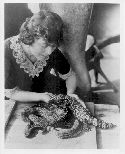
Grace Olive Wiley was an American herpetologist best known for her work with venomous snakes. She died of a snakebite she received while posing for a photographer at the age of 65.

Halobates or sea skaters are a genus with over 40 species of water striders. Most Halobates species are coastal and typically found in sheltered marine habitats, but five live on the surface of the open ocean and only occur near the coast when storms blow them ashore. These are the only known truly oceanic, offshore insects. They are found in tropical and subtropical marine habitats around the world, with a single species recorded in rivers a few kilometers upstream from the ocean. Halobates are generally very common.

Gerris lacustris, commonly known as the common pond skater or common water strider, is a species of water strider, found across Europe.

Aquarius remigis, known as the common water strider, is a species of aquatic bug. It was formerly known as Gerris remigis, but the subgenus Aquarius was elevated to generic rank in 1990 on the basis of phylogenetic analysis. Aquarius remigis is found throughout North America, but is most prevalent in the mid-west of the United States.
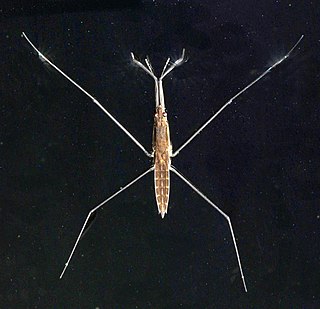
Aquarius najas, also known as the river skater, is a European species of water strider. It was formerly known as Gerris najas, but the subgenus Aquarius was elevated to generic rank in 1990 on the basis of phylogenetic analysis.
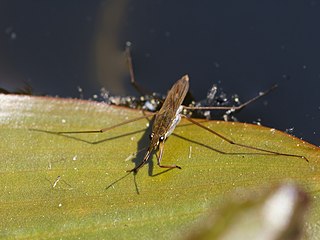
Gerrinae is a subfamily of water strider. This subfamily includes the largest and most best-known group of Gerridae. They are also a phylogenetic subfamily made up of two tribes, and ~14 genera.

Gerris is a bug genus in the family Gerridae.
The Entomological Society of Washington was organized on February 29, 1884 at a meeting called by three entomologists employed by the U.S. Department of Agriculture: Charles Valentine Riley, Eugene Amandus Schwarz, and Leland Ossian Howard, in Riley's home in Washington, D.C. Meetings have been held regularly since 1884. Several local locations were used as meeting places after it became impractical to hold meetings in members' homes, including the Washington Saengerbund Hall, the Cosmos Club, and the National Museum of Natural History of the Smithsonian Institution.

Aquarius is a genus of water striders found predominantly in the northern hemisphere. Formerly a subgenus, Aquarius was elevated to generic rank in 1990 on the basis of phylogenetic analysis. These are among the world's largest water striders, with females averaging 12–17 mm (0.47–0.67 in) long and males roughly 10–30% smaller, depending on the exact species. An outlier is A. elongatus where both sexes typically are about 24 mm (0.94 in), roughly the same as certain Cylindrostethus, and second only to Gigantometra gigas.
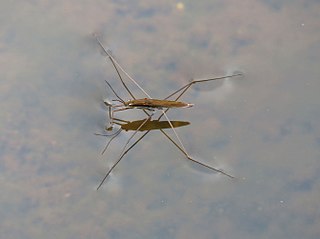
Limnoporus is a genus of water striders in the family Gerridae. There are six extant described species in Limnoporus.
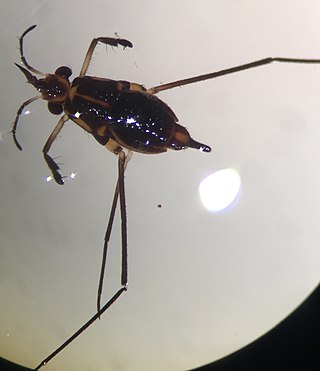
Rheumatobates is a genus of water striders in the family Gerridae. There are more than 30 described species in Rheumatobates.

Rheumatobates vegatus is a species of water strider in the family Gerridae. It is found in the Caribbean Sea, Central America, and North America.

Aquarius conformis is a species of water strider in the family Gerridae. It is found in eastern North America from Quebec west to Wisconsin and south to Florida and Mexico.
Gerris buenoi is a species of water strider that belongs to the family Gerridae. It was first identified in 1911 and is native to continental USA and Canada. Individuals of this species are small in size and have modified appendages, allowing them to float and "skate" along the surface of the water. G. buenoi can be found near the shoreline of freshwater ponds and small lakes, where they hunt for terrestrial insects that have fallen into the water.

Halobates micans is a species of water strider in the family Gerridae. It is one of five Halobates species that live on the surface of the open ocean, only occurring near the coast when storms blow them ashore. Unlike the others that are restricted to the Indian and/or Pacific Oceans, H. micans is circumglobal, occurring offshore in warmer seas around the world. It is the only Halobates species found in the Atlantic Ocean where it ranges from about 40° north to 40° south.

Hermatobates is a genus of wingless marine bugs placed as the sole genus in the family Hermatobatidae that are sometimes known as coral-treaders. They are quite rare and known only from coral reefs in the Indo-Pacific region. During low tide, they move over the water surface not unlike the more familiar water-striders around coral atolls and reefs and stay submerged in reef crevices during high tide.
Gigantometra is a monotypic genus of water-strider bugs, containing the species Gigantometra gigas: its name indicating that it is the largest species in its family Gerridae. It has been found in pools of fast-flowing, subtropical and tropical forest streams, on Hainan Island and highland northern Vietnam.















